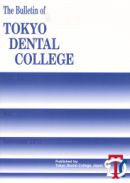
- Issue 1 Pages 1-
- |<
- <
- 1
- >
- >|
-
Tomofumi Takano, Masao Yoshinari, Kaoru Sakurai, Takayuki Ueda2024 Volume 65 Issue 1 Pages 1-9
Published: 2024
Released on J-STAGE: March 07, 2024
Advance online publication: February 15, 2024JOURNAL FREE ACCESSThe present study investigated the cyclic fatigue properties of titanium alloys (Ti-6Al-4V and Ti-6Al-7Nb) as implant materials and compared their properties with those of commercially pure titanium. Ti-6Al-4V and Ti-6Al-7Nb cylinders with diameters of 3.0 mm were examined. The surfaces of the cylinders were roughened by sand blasting with alumina particles and acid etching. Static and cyclic tests were performed according to ISO 14801:2016. The yield force in the static test (YS) was measured in 5 specimens of each alloy using a universal testing machine. The yield force in a cyclic test (YC) was measured in 20 specimens of each alloy using the staircase method, which involved applying a cyclic load at a frequency of 10 Hz for 106 cycles. After the cyclic loading tests, cross-sections of the specimens were examined under an optical microscope. The YS values for Ti-6Al-4V and Ti-6Al-7Nb were 1463 N±93 N and 1405 N±79 N, respectively, and the YC values were 870 N±58 N and 853 N±202 N, respectively. Microscopic observation revealed cracks on the tensile side of some of the specimens, including run outs and failures. The results of this study suggest that the YC values for Ti-6Al-4V and Ti-6Al-7Nb were 40% less than those for YS. The yield force of Grade-4 Cp-Ti significantly decreased after cyclic loading. The YC values for Ti-6Al-4V and Ti-6Al-7Nb were approximately 900 N, which was markedly greater than that for commercially pure, Grade-4 titanium (700 N).
View full abstractDownload PDF (701K) -
Hidetomo Hirouchi, Ryu Suzuki, Shinya Hanada, Yuki Takeuchi, Yuki Sugi ...2024 Volume 65 Issue 1 Pages 11-17
Published: 2024
Released on J-STAGE: March 07, 2024
Advance online publication: February 15, 2024JOURNAL FREE ACCESSThe morphogenetic process of development of the circumference of the mandibular fossa during tooth eruption, which involves the replacement of deciduous teeth with permanent teeth, is strongly affected by occlusion. To the best of our knowledge, no studies have investigated the effect of occlusion on this process. This study investigated the morphogenetic process of development during tooth eruption using dried skulls harvested from Indian donors. The average distance between the ala-major-squamosa suture and the foramen ovale according to age group was as follows: 3.24 mm in the 8-month-old group and 8.92 mm in the adult group. The average distance between the ala-major-squamosa suture and the apex of the articular tubercle according to age groups was as follows: 10.38 mm in the 8-month-old group and 19.34 mm in the adult group. The average distance between the point of intersection of the petrosquamous fissure and petrotympanic fissure located on the perpendicular line drawn posteriorly from the shortest distance of the medio-lateral axis between the ala-major-squamosa suture and the apex of the articular tubercle according to age group was as follows: 9.68 mm in the 8-month-old group and 14.3 mm in the adult group. These results suggest that the mandibular fossa is strongly affected by load due to occlusion, unlike the growth of the neurocranium. This indicates that the effect of occlusion is a secondary element in the morphogenetic process of development of the circumference of the mandibular fossa.
View full abstractDownload PDF (319K)
-
Noriko Sano, Ryota Sano, Junji Ohtani, Saiji Shimoe, Hiroki Nikawa, Ta ...2024 Volume 65 Issue 1 Pages 19-27
Published: 2024
Released on J-STAGE: March 07, 2024
Advance online publication: February 15, 2024JOURNAL FREE ACCESSThis case report describes a 19-year-old woman with skeletal Class I crowding and an unsalvageable maxillary right central incisor. She visited our clinic with the chief complaint of mobility of the maxillary right central incisor due to a traffic accident. After extraction of the maxillary right central incisor, the space was closed orthodontically. All the maxillary right teeth were moved mesially with an elastic chain attached to a palatal lever arm which was connected to palatal temporary anchorage devices (TADs). After orthodontic treatment had been completed, the maxillary right lateral incisor and peg-shaped left lateral incisor were restored with a porcelain laminate veneer. The maxillary right canine was morphologically reshaped and built up with composite resin. Consequently, esthetically ideal occlusion and functional lateral guidance with uncontacted molars were obtained. These results show that mesial movement of the entire dental arch with TADs is a useful orthodontic treatment option in patients in whom the maxillary central incisor has been extracted.
View full abstractDownload PDF (714K)
- |<
- <
- 1
- >
- >|